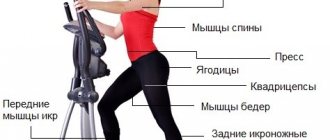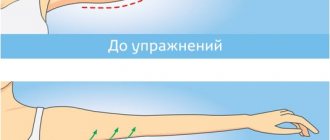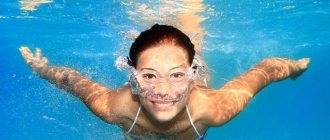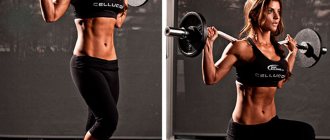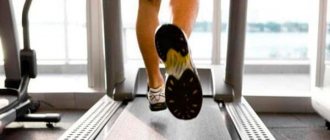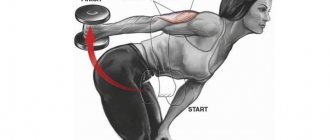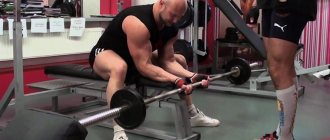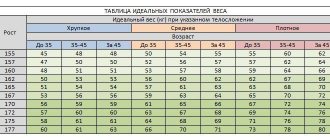Not muscles, but “mountain”? In fact, this is the reality for every bodybuilder. This very reality is called pumping. The bottom line is that in the process of performing special exercises, certain muscles are visually pumped. They acquire super-volume, which lasts for 20-30 minutes (sometimes up to 1 hour). Bodybuilders most often resort to pumping before going out in public. Pumping does not provide enormous strength and endurance, but it looks great. Pumping has no gender restrictions - it is used simultaneously by representatives of the strong and weak half of humanity.
The best training programs for pumping muscles
There are several programs for pumping different muscle groups and areas of the body (types of pumping training). They were compiled by experienced trainers using personal trial and error. The complex must be carried out strictly according to plan in order to achieve visible and desired results. The effect is visible after the first lesson. Over time, the pumping effect will last longer. The muscles will remember this feeling and try to maintain it.
Body reaction to pumping training
Pumping works physiologically this way:
- The same movements, when duplicated at high speed, lead to the nervous system working in a stressful mode. The brain centers promote increased acceleration of blood flow and send all the necessary substances to the tissues;
- Muscle fibers facilitate the penetration of blood cells into them, which cannot exit immediately due to compression of the capillaries and high tension;
- When the exercise is repeated after a long break, the pressure in the fibers decreases and the blood gradually flows in the opposite direction. Ultimately, the muscle tissue returns to its normal state.
Muscle pumping does not consolidate the result and is called “cosmetic”. Most often it is used by bodybuilders in competitions before going on stage. But if you wish, you can try to develop it into a “productive” form.
“Productive” pumping is adding exercises without rapid repetitions. At some point, increased blood flow is formed, which leads to euphoria. From a psychological point of view, this gives strength and has a great effect on the intensity of the next workout. This constant practice warms up the fascia (the “bags” that contain the muscles) and makes them easier to stretch.
You can achieve muscle swelling with the help of sports nutrition and pharmacology - injections, tablets. But the so-called “Pharmacological” pumping proceeds artificially and can be fraught with health hazards if the sports nutrition is improper.
Video: What is pumping. Its varieties
Pumping the pectoral muscles
Includes:
- bench press in a lying position;
- butterfly;
- bent over dumbbell flyes;
- Bent-over dumbbell press;
- pullover,
- information in the crossover through the lower blocks.
You need to perform the exercises using trisets, for example – bench press, butterfly and pullover, the second option – bent over dumbbell press, bent over dumbbell flyes, crossover exercises through lower blocks. This means alternating exercises, performing them one after another without rest breaks. This rather heavy type of pumping, such as negatives, is also very suitable for the chest. The bottom line is that you first need to isolate the muscle, then pump it well. An example would be to perform the butterfly exercise - since it is isolating, and then do the base - the bench press. You need to start with 3 sets of 10-15 repetitions. Over time, it is imperative to increase the number of approaches and repetitions. After a month there should be at least 6 approaches for the pumping to be noticeable. Exercises can be performed using various pumping techniques. The main thing is to gradually increase the number of repetitions without fail.
What is pumping?
Pumping, that is, pumping muscles with blood, gives an unforgettable sensation - this is the most obvious advantage of the described technique. It's nice to look at your enlarged muscles, observing the effect here and now.
How to achieve pumping?
How is this achieved? What is the essence of pumping style training?
- In the pumping style, as a rule, no more than two muscle groups are worked out in one workout.
- The exercises chosen are mainly isolating ones, that is, those in which one muscle group works. Give preference to those movements in which you feel this small muscle group as well as possible.
- The weight is selected in such a way that in one approach you get at least 15 “clean” repetitions, preferably more, up to 20-25. “Cleanliness” is extremely important - the technique must be perfect, the feeling of work must be only in the target muscle group! Accordingly, each repetition is performed under control.
- At the end of each approach, you should feel a pronounced burning sensation in the target muscle. The maximum burn will be the limiting factor on the way to completing the next repetition. To fulfill this condition, avoid the “extreme point” in the exercise - complete relaxation of the muscle (for example, do not fully extend your arms in presses or when doing biceps curls), which should always be in good shape.
- It is not necessary to fix the muscle during peak contraction, although it is quite possible, thereby achieving even greater difficulty in the outflow of blood from the working muscle and, accordingly, an even greater pump effect.
- In addition to the simplest option with performing the exercise for 15-25 repetitions, there are several more complex schemes that help achieve the same blood supply to the muscles: supersets, drop sets, concentration on the negative phase of the movement, etc. The optimal option would be to include several in the complex similar schemes or alternate them to give the muscles a new stress each workout.
The benefits of pumping
The point of all of these actions is to maximize blood flow to the muscle, while at the same time reducing the outflow. This leads to oxygen debt and acidosis - acidification of muscle fiber. Acidification is due to the fact that if the outflow of blood is disrupted, the inflow also slows down, which means that oxygen does not have time to reach the working muscle in the required quantity.
To provide the working fiber with energy, cells switch to the anaerobic, that is, oxygen-free path of oxidative phosphorylation or energy production - ATP. During the oxygen-free pathway of energy production, metabolic by-products are formed - hydrogen ions. They are the ones who change the environment inside the cell. From a biological point of view, this damages the quaternary structure of the protein of the cell nucleus, which makes it easier for anabolic hormones to access it. It is thanks to the action of hormones at the cellular level that our muscles grow and recover faster.
However, do not forget that when pumping, a small working weight will be used (otherwise you will not be able to complete the specified number of repetitions), which will be a much smaller stimulus for muscle growth than with classical training. A small increase in the flow of hormones to muscle fibers is not a sufficient factor for successful mass gain.
Back pumping
Good for back pumping:
- classic deadlift, sumo;
- Bent-over barbell row;
- upper block thrust;
- traction to the waist while sitting;
- Pull-ups with a wide grip behind the head.
They need to be performed without breaks using the method of supersets and trisets. Option one – classic deadlift, bent-over barbell row, lat pulldown. Option two – pull-ups with a wide grip behind the head, rows to the waist while sitting. Other pumping methods are also applicable here, burning, for example, or even pre-fatigue. The back muscles are weak to pumping, so they require special attention from the bodybuilder. Stepped approaches can be used.
Pumping for the buttocks
Ideal for this type of pumping:
- squats;
- Dead deadlift on straight legs;
- leg abduction;
- lunges;
- hyperextension;
- gluteal bridge.
All exercises must be done in sets, then they will bring the most beneficial effect. For example, deadlift + glute bridge, barbell squats + leg abductions, lunges + hyperextension.
Arm pumping (biceps, triceps)
For this type of pumping the following would be appropriate:
- Bending arms with handles using upper crossover blocks;
- Hammer exercise;
- Concentrated arm curl with a dumbbell while sitting;
- Biceps exercises on the Scott bench;
- French bench press;
- Close grip bench press;
- Extension from behind the head;
- Blocked triceps extensions.
Here you can use different pumping methods (super sets, drop sets, partial repetitions, pre-fatigue, peak contraction, burn). This area of the body can be easily enlarged and pumped up. It’s important not to overdo it, but underdoing is also bad; the pumping simply won’t be visible. In moderation - this is the main principle of pumping this zone. You need to start with 3 approaches and 10-15 repetitions. Increase over time is necessary.
Pumping mechanism
When you pump, you purposefully pump blood into your muscles. There are certain ions in the blood that pull water with them. Thus, liquid penetrates the cells and fills them, increasing their volume. Totally swollen cells give a 5–10% increase in muscle volume.
Due to pumping, any person receives a small visual increase in muscle mass.
Blood is pumped into the muscles through exercise. The process is accompanied by a specific sensation of muscle expansion: it is difficult for you to bend your arm, for example, because your biceps is in the way. At this moment you feel more, which is confirmed both visually and to the touch. It's like you're full of water.
What is pumping in practical terms? It is multi-repetition training in which the number of repetitions reaches 15 or more.
The pump effect can be caused by:
- Physical activity.
- Special additives.
In the first case, everything is clear - they came, swayed properly, and everything was ready. In terms of supplements, things are a little different.
The essence of the drugs is to retain fluid in the body. The range of drugs is large, ranging from arginine-containing supplements to steroids. Creatine and some fat burners retain water. Please note that the accumulation of water in the body can have negative sides!
Shoulder pump
Ideal exercises would be:
- Military press with a barbell or dumbbells;
- barbell pull to the chin;
- abduction of arms with dumbbells to the side;
- Arnold press;
- raising your arms with dumbbells in front of you.
You need to start with the notorious 3 approaches and 10 repetitions, performing the exercises in supersets. You can take short breaks between approaches. Shoulder pumping is achieved quickly with the correct load on this area. The effect lasts about 30 minutes.
Standard workouts
Standard training involves a set of strength exercises. In addition there is pumping. It is performed by all bodybuilders - beginners and experienced. This can be any exercise with dumbbells. You need to do as many repetitions as possible with a minimum interval between these same repetitions. If everything is done correctly, the pumping will be visible visually. The muscle will grow and greatly increase in volume. The effect will last from 20 minutes to an hour.
Pumping on the press
Abdominal pumping consists of two basic exercises. This is a hanging leg raise and twisting. Leg lifts must be performed on a special horizontal bar. You can lean on the handrails with your elbows or hang by grabbing the bar. This is not the main point. The legs should be raised at a right angle or tucked towards the stomach at the knees. This exercise works great for muscles. Immediately after it, you need to lie on the floor and do about 30 crunches. Over time, the number of repetitions must be increased, otherwise there will be no effect.
Leg pumping
Here, experienced athletes recommend performing squats and leg bending and extension. Ideally, both pumping exercises will be performed in superset mode, then the benefits will be obvious quickly. You don’t need to squat deeply, not all the way, it’s enough to sit down on a chair. At first, you can perform the exercise next to a chair and bench, as if sitting down on them. You need to start with 10 repetitions and 3 approaches, after a month the amount should be increased by 2-3 times.
Pumping in bodybuilding
Strength training involves “overloading” the muscles. Which may be the cause of delayed onset muscle pain . Naturally, it interferes with carrying out a full training session if it does not take place before the next training session. Therefore, it is recommended to avoid it! But it is well known that greater load gives greater results. True, only if the body manages to “digest” it. And it is precisely to “digest” the load that pumping training can help. Which are best done between training sessions. Not to mention, they help improve neuromuscular communication. Because the more often you use something, the better you get at it.
You can use pumping in bodybuilding and as an independent training program. What should you do after going through any power circuit. Because pumping helps you recover after it. Moreover, it is during this recovery period that the main synthesis of muscle proteins will occur. Which the athlete had previously actively destroyed with strength training for 2–6 repetitions to “failure.” And precisely because this is rehabilitation training, which should also ensure restoration of the musculoskeletal system, it is recommended to use simulators and isolation exercises for pumping. Just to avoid overloading your joints!
Muscle hypertrophy system
Bandages for pumping
Pumping training for women
Programs for the fair sex do not differ much from those combinations that are offered to the stronger sex. The only relaxation is the number of approaches and repetitions. Ladies can start with the same 3 sets of 8-10 reps. The number needs to be increased. After a month, there may be 5 approaches and 15 repetitions. It all depends on what effect the athletic lady expects from pumping.
